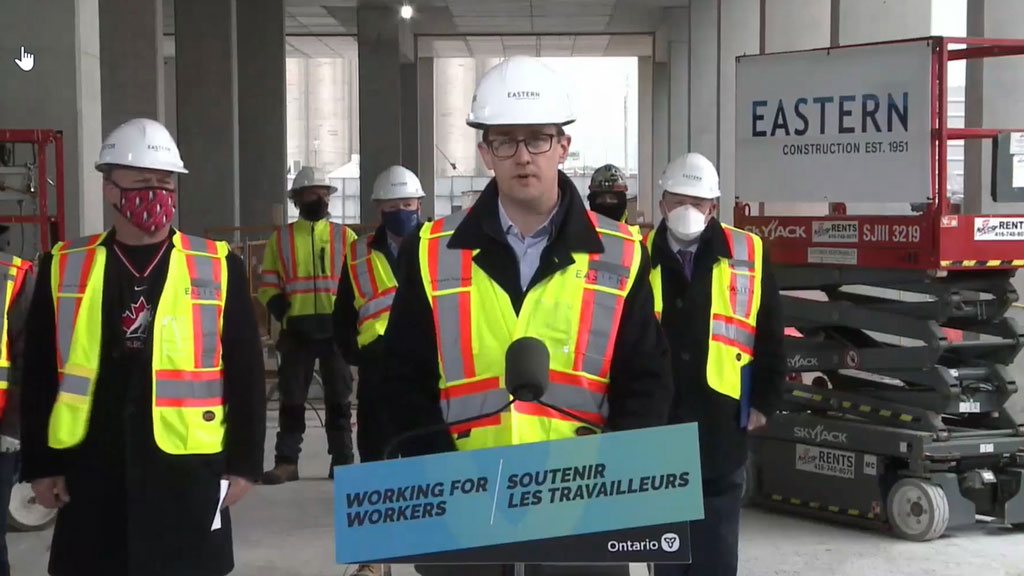The Ontario government’s proposed legislation to require all construction sites in Ontario to have naloxone kits onsite is a big step in the right direction, says the Ontario Construction Consortium (OCC).
The measure is one of the key recommendations identified in The Other Pandemic Campaign, launched by the OCC last year to raise awareness on the opioid overdose crisis in the construction industry.
“We are pleased that the government is taking action on this situation,” said Phil Gillies, executive director of the OCC. “We are delighted that the Ontario government is implementing one of the key recommendations of our The Other Pandemic Campaign. It’s all about improving the lives of construction workers wrestling with addiction and it’s all about saving lives.”
Minister of Labour, Training and Skills Development Monte McNaughton and Associate Minister for Mental Health and Addictions Michael Tibollo were at the T3 Bayside construction site in Toronto March 1 to make the announcement.
Naloxone is a fast-acting drug used to temporarily reverse the effects of opioid overdoses. It can prevent death if administered quickly.
According to a study 2,500 Ontarians died of drug overdose in 2020 and of those who were employed at the time of their death, 30 per cent were construction workers, Gillies explained.
The Working for Workers Act, 2022, if passed, would mandate workplaces that are at risk of a worker opioid overdose such as construction sites, bars and nightclubs, to have naloxone kits.
“To save lives we must get naloxone kits into people’s hands. We must do everything possible and today we’re turning our pain into action,” said McNaughton, thanking Gillies and the OCC for their work and leadership on the issue.
“We have to be ambitious in fighting this epidemic. We have to propose solutions that match the scale of this crisis. This new policy is a first in Canada. It will help keep workers safe and also save clients, customers or anyone else in an emergency and it will be matched with support from our government to train workers and help employers get the kits they need.”
The legislation also recommends training to ensure workers are familiar with how to use naloxone kits. In addition, the Occupational Health and Safety Act (OHSA) would not limit or prohibit the use of naloxone to clients, customers or anyone else in an emergency.
If it even saves one person, it’s worth having them on the sites. It just furthers the conversation and makes it not a taboo subject
— Giovanni Cautillo
Ontario General Contractors Association
Paul Rosen, a Paralympic gold medalist, was also in attendance for the announcement. Rosen, 62, said he struggled for many years with addiction and mental health.
“When I retired after the Vancouver (Paralympics) my addiction was still going on and my mental health, and unfortunately not being a Canadian athlete anymore, everything went downhill,” said Rosen, adding having naloxone available is critical.
“The opioid crisis in Ontario is massive and it’s not the stereotypical addict that we think of. It’s killing so many young men young women,” said Rosen. “The biggest problem is we have incredible emergency services in this province but when somebody goes down and it takes three, four, five minutes for an ambulance to come…naloxone will get you to the hospital, it will save you.”
Tibollo agreed the opioid crisis has been intensified by the COVID-19 pandemic.
“Ontario’s construction industry and Ontario’s workers never took a break during the pandemic,” Tibollo said. “The proposed amendments to the Occupational Health and Safety Act, which includes requiring naloxone kits in certain workplaces and staff training on how to use them, is truly something that will support people with addiction challenges and reduce harms resulting from opioid use.”
The OCC recently released a second video as part of The Other Pandemic campaign featuring McNaughton, Giovanni Cautillo of the Ontario General Contractors Association, and Patrick Brown, mayor of the City of Brampton, discussing the opioid crisis in construction.
“Having naloxone kits on construction sites ultimately would be akin to the AEDs (automated external defibrillator) that you have onsite,” said Cautillo in the video. “To me, in my mind there is no difference. If it even saves one person, it’s worth having them on the sites. It just furthers the conversation and makes it not a taboo subject but instead part of our vernacular.”
For more on the campaign visit TheOtherPandemic.ca.
Also included in Working for Workers Two are changes to the OHSA and a proposal to increase the maximum fines for businesses that fail to protect their workers and follow workplace health and safety laws. This would reinforce the importance of putting worker safety first and further penalize those that treat injuries as the cost of doing business, McNaughton said. Businesses that do not provide a safe work environment that leads to a worker being severely injured or dying on the job could face fines of up to $1.5 million under the OSHA if convicted, states a release, adding charges for other individuals are also rising to up to $500,000.
Follow the author on Twitter @DCN_Angela.











Recent Comments
comments for this post are closed